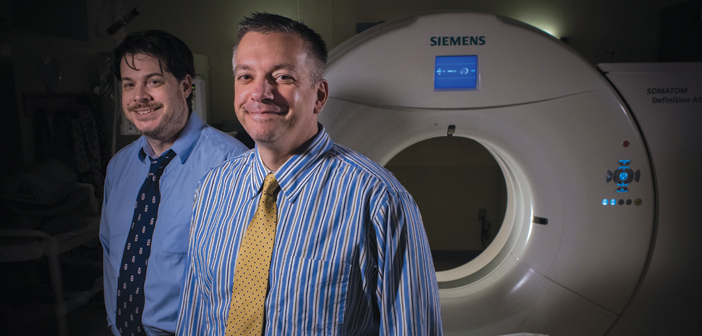Physicians and scientists look for answers in new dimensions.
This is where the magic happens: in a dimly lit corner of an ordinary computer lab behind a nondescript door in a drab corridor of Rhode Island Hospital.
At first the images on the oversized computer monitors where Scott Collins, RT(R)(CT), and Derek Merck, PhD, tap away seem as unremarkable as the surroundings: blurry, black-and-white diagnostic scans that only a scientist could love.
But with a few keystrokes, Collins is guiding a visitor on a virtual tour down a trachea and into a lung; then through a coronary artery and left atrium of a heart; then up a spinal column to peer through a cavity in the cervical vertebrae where a tumor once encroached.
Those inscrutable, two-dimensional pictures were mere raw material for the vivid, 3-D videos that Collins created on his desktop, as well as the models of spines and skulls the lab builds with a 3-D printer, and the larger-than-life renderings they project into a virtual reality theater, known as the Yurt, on Brown’s main campus.
“It’s almost like 4-D, where you’re immersed in it,” Clinical Assistant Professor of Neurosurgery Adetokunbo Oyelese, MD, PhD, says of the latter tool. Late last year he donned antennae-spiked goggles in the Yurt to view pre- and post-op images of his patient’s spinal tumor. The sensation of standing inside a spine is so real, he says, it feels like “you literally walk down that path.”
Collins, the lead CT technologist at the hospital, says, “It’s just another way of looking at it from a new perspective.” But that perspective, says Oyelese, who’s also the assistant director of the neurosurgery residency program, has major educational potential. “They’re giving you an almost palpable 3-D image,” he says. For surgeons-in-training, “the hardest thing is translating 2-D to 3-D in your mind.”
We’ve always tried to push the limit and see what we could come up with.
Merck, an assistant professor with joint appointments in diagnostic imaging and engineering, has made a career of bringing computer science and graphics to medicine. He says he and Collins, who began working with 3-D imaging software in the 1990s, fulfill the mission of the hospital’s 3-D lab in complementary ways. “He knows the anatomy, the machines, the clinic; I know the esoteric math,” Merck says. Both train and mentor residents and students, including students in engineering and computer science.




